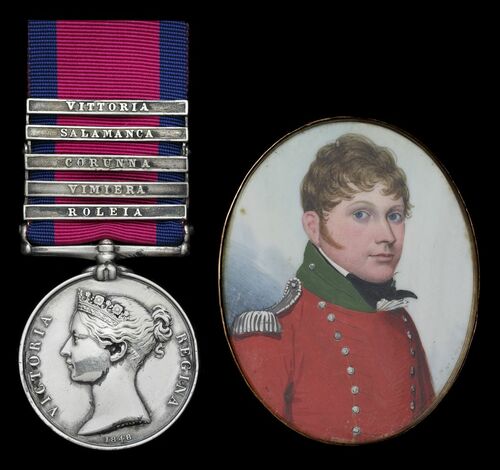
Auction: 24001 - Orders, Decorations and Medals
Lot: 6
(x) The Military General Service Medal awarded to Lieutenant & Adjutant J. Leech, 5th (Northumberland) Regiment of Foot, accompanied by a portrait miniature of the recipient by one of the most renowned military miniaturists of the Napoleonic Wars
Military General Service 1793-1814, 5 clasps, Roleia, Vimiera, Corunna, Salamanca, Vittoria (J. Leech, Lieut & Adjt 5th Foot); Portrait Miniature, an officer of the 5th (Northumberland) Regiment of Foot, facing half-right, wearing a fully-fastened red coat with green facings, one silver epaulette to the right shoulder, mounted in a gold-coloured glazed frame, the reverse bearing a pin and engraved initials 'J.L.' to centre, 53mm x 67mm, unsigned but very clearly by Frederick Buck, traces of old lacquer to first, minor edge knock, good very fine (2)
John Leech is confirmed upon the Medal Roll with correct entitlement to these five clasps, a unique number and combination to the Regiment. Appointed Lieutenant in the 1st Battalion, 5th Foot on 7 March 1805, he may well have been present with them during the expedition to Monte Video in 1806-07 as part of Lieutenant-General John Whitelocke's bungled attempt to capture the city and which led to an ignominious defeat and Whitelocke's dismissal from the Army.
Returning to Europe in December 1807 and landing at Cork, in July 1808 the 1st Battalion (having remained in the area) embarked for Portugal to join Sir Arthur Wellesley's army. Arriving on 9 August, a mere eight days later they saw action at the Battle of Rolica - the first British battle of the Peninsular War. Stationed on the right flank of Wellesley's force, the 5th saw their fair share of fighting and indeed were later specifically mentioned in the commander's despatch: 'I cannot sufficiently applaud the conduct of the troops throughout this action. The enemy's positions were formidable, and he took them up with his usual ability and celerity, and defended them most gallantly. I must observe, that although we had such a superiority of numbers employed in the operations of this day, the troops actually engaged in the heat of the action were, from unavoidable circumstances, only the Fifth, Ninth, Twenty-ninth, the riflemen of the Sixtieth and Ninety-fifth, and the flank companies of Major-General Hill's brigade, being in number by no means equal to that of the enemy;—their conduct therefore deserves the highest commendation.' (Historical Record of the Fifth Regiment of Foot, or Northumberland Fusiliers; containing an account of the formation of the Regiment in the year 1674, and of its subsequent services to 1837, p. 62 refers). At the Battle of Vimeiro, four days later, the regiment were not so heavily engaged and the Convention of Cintra was signed shortly afterwards.
Remaining in Portugal, the 5th were next assigned to join Lieutenant-General Sir John Moore's army in Spain; after marching some 400 miles in a short space of time, the subsequent retreat to Corunna is well known in the history of the Peninsular War as one of great privation and hardship to all involved - undoubtedly Leech would have experienced this first-hand and marched with his men all the way through the wet, cold, mountainous terrain. During the battle itself, on 16 January 1809, the 5th were positioned on the extreme left flank of the British position and saw their fair share of the fighting - indeed, after having a horse shot from under him the commanding officer, Colonel Mackenzie, was mortally wounded and command developed on the senior major; upon returning to England the battalion recorded that it had suffered casualties of some 133 men killed and missing.
With little time to recuperate, the 1st Battalion next found themselves earmarked for the expedition to Walcheren for another mismanaged campaign where more men died of disease than were ever in action against the French: starting out almost 1000-strong, almost 600 succumbed to the infamous 'Walcheren Fever' - Leech may have been one of these, but fortunately (and unlike several fellow officers) he survived. Meanwhile, the 2nd Battalion were sent on active service to the Iberian Peninsula and participated in several major actions including the sieges of Ciudad Rodrigo and Badajoz, and earned a name for themselves for their gallantry in the face of overwhelming numbers at the 'Affair' at El Bodon in September 1811. Having recovered their numbers and health, the 1st Battalion was also given orders to sail for Spain - this led to a most unusual circumstance, where both battalions of the same regiment fought side-by-side in the same campaign; by this point Leech appears to have been appointed Adjutant, a position of important responsibility within the unit and which would have seen him working closely with the Commanding Officer to ensure the efficient running of the battalion. He may well have been in the thick of the action at Salamanca (22 July 1812) when the 1st Battalion were charged by French cavalry; allowing them to 'advance so close that every shot would tell', the unit opened such an effective fire with volleys of musketry that their enemy were immediately repulsed. It was not all one-sided however, as by the end of the battle they had lost some 150 officers and men killed and wounded.
With the 2nd Battalion then returning home and the 1st sharing the privations of the retreat from Burgos (likened by many - probably including Leech - to as bad as the retreat to Corunna), during the 1813 campaign the battalion saw much fighting at the Battle of Vittoria (21 June 1813) when as part of Sir Charles Colville's brigade they forded the river under heavy fire and drove in the French 'in gallant style'. Leech had been promoted Captain only a few days previously (10 June) and would likely again have been in the thick of the action if officer casualties alone are any indication, with four killed and four wounded.
Whilst the 5th Foot remained in the Peninsula through to the end of hostilities (participating in the battles of the Nive, Nivelle, Orthes and Toulouse) Leech does not appear to have been present: the Medal Roll notes him as being retired on Full Pay and an officer with the 5th Royal Veteran Battalion, and he also served as a Captain in the 1st Royal Veteran Battalion, being appointed to that unit on 25 December 1822 (London Gazette, 8 February 1822, refers).
Postscript: Though unsigned, the accompanying portrait miniature is very clearly by the well-regarded artist and miniaturist Frederick Buck (1771-1839/40), known for his prolific work in creating portraits of British officers actively involved in the Napoleonic Wars. Additionally based in Cork, considering that the 1st Battalion 5th Foot returned to that city from South America and sailed from there to the Iberian Peninsula, it is fair to surmise this portrait was painted some time between December 1807 - July 1808.
Subject to 5% tax on Hammer Price in addition to 20% VAT on Buyer’s Premium.
Sold for
£6,500
Starting price
£2700




